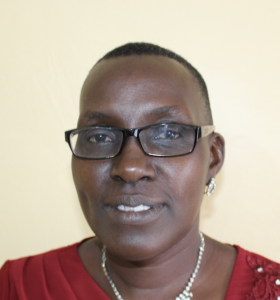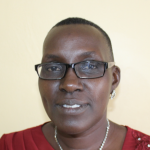It was a hot and sunny day when we arrived at Khabukoshe Primary School. This school was established in 1938 with a population of 100 pupils. Since then, it has grown to a population of 700 pupils.
It is located in a busy area with business men and women who work at Harambee Shopping Center. The place is very green with maize growing along the roadside.
The teachers lead classes in mathematics, English, Kiswahili, science, and social studies. However, their students' success in these subjects is disrupted by the conditions in which they must attend school.
There is no clean water source on school grounds. There is an open, unprotected hand-dug well there. This is essentially a hole in the ground with a hatch over it. On the day of our visit, this well was dry and students had to carry containers of water from home that morning.
Students are at risk of falling in the well when fetching water. When the well has water, students tie a rope to a bucket and lower it down.
This lack of safe water for drinking means that pupils don't drink water throughout the day. The school cook uses this water to make lunch, which compromises the health of students who eat lunch there. When students need to carry water from home, they arrive tired and worn out from the heavy weight of their water containers.
What we can do:
Training
Our visits and interviews at the school showed us that students need training on personal hygiene, environmental hygiene, water pollution, dental hygiene, and handwashing.
Training on good hygiene habits will be held for two days. The facilitator will use PHAST (participatory hygiene and sanitation transformation), ABCD (asset-based community development), CTC (child to child), lectures, group discussions, and handouts to teach health topics and ways to promote good practices within the school. The CTC method will prepare students to lead other students into healthy habits, as well as kickstart a CTC club for the school.
Handwashing Stations
This CTC club will oversee the new facilities, such as handwashing stations, and make sure they are kept clean and in working condition. The two handwashing stations will be delivered to the school, and the club will fill them with water on a daily basis and make sure there is always a cleaning agent such as soap or ash.
VIP Latrines
"Sometimes I am not able to use the latrines since they are very dirty," said Pauline Mmbasu.
Two triple-door latrines will be constructed with local materials that the school will help gather. Three doors will serve the girls while the other three serve the boys. And with a new source of water on school grounds, students and staff should have enough to keep these new latrines clean.
Rainwater Catchment Tank
A 50,000-liter rainwater catchment tank will help alleviate the water crisis at this school. The school will also help gather the needed materials such as sand, rocks, and water for mixing cement. Once finished, this tank can begin catching rainfall that will be used by the school’s students and staff.
We and the school strongly believe that with this assistance, standards will significantly improve. These higher standards will translate to better academic performance!

 Rainwater Catchment
Rainwater Catchment
 Rehabilitation Project
Rehabilitation Project



































